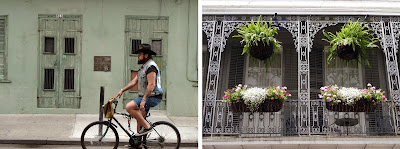At this point, one of the overarching themes that seems to be emerging out of this tour is change and how individuals and societies choose to respond to it.
In Baltimore, noted preservationist Charles Duff gave us a startling glimpse of the contrasts in the city by way of architecture. First through genteel neighborhoods with rows of elegant tall and narrow houses that evoke London and New York. Streets are clean, facades are painted, foliage is healthy and well-maintained. Then, mere blocks away, the terrifying sight of similar rows of houses, but with windows darkened, boarded up, and broken, roofs and ceilings fallen in, empty lots where houses had once stood. So great was the difference between East and West Baltimore that it was hard to believe that we were seeing not just the same city, but the same urban center.
From Mr. Duff's commentary, it was clear that he wanted nothing more than to restore the city to its former glory, even if it meant bringing in more immigrants to populate these areas abandoned by their former tenants for the suburbs.
On the set of Treme in New Orleans, show creator David Simon expressed similar views, agreeing that larger socioeconomic forces had caused Baltimore to decline. He also expressed a desire to see New Orleans restored to the vibrant cultural center that it was before the tragedy of the levees, saying that it was important to preserve the culture that was so important to the character of New Orleans.
Change is difficult, often painful. I believe human beings are essentially creatures of habit, seeking out the comfort of the same and the routinary as a way of imposing order upon chaos. In his columns for the New York Times, New Orleans native John Biguenet writes poignantly of the wrenching decisions that had to be made in the aftermath of the flood in New Orleans -- should he and his wife return to the familiar life he had built over the years, or start completely anew? He tells of Spanish moors exiled to North Africa who hung the keys to their old homes in Spain on the front doors of their new homes, believing in their hearts that their families would one day return. Mr. Biguenet also told of a New Orleans coffees shop destroyed by the flood, whose loyal patrons (himself included) brought their own coffee and paper to the site and enjoyed their morning routine there until the cafe reopened. The familiar grounds and centers people, provides them with a stable base from which to branch out and develop in new directions, or can lull them into stasis. But progress seems impossible to bring about in a state of flux.
On the "disaster tour" of New Orleans, the tour guide diligently pointed out homes and buildings that had since been rebuilt, and those that had not. The latter were evidenced by structures in decay, or by empty lots, a glaring absence where there had once been presence. The recurring theme of her commentary was "coming back," indicating her desire to see the spaces as they once were.
But do things need to come back, and do they need to come back in exactly the same form as before? A disaster can wipe the slate clean, and the terrible blankness also signifies endless possibility. In mythology, orphans are powerful symbols, the mystery of their origins suggesting they could have come from anywhere -- even royalty or the heavens -- and that, more importantly, they could become anything, unbound as they are by the limitations of any history.
Do Baltimore and New Orleans have to return to their former selves? Or can they be unfettered, allowed to grow in directions more appropriate for the changes wrought by nature, economics, politics, social upheaval, and time?
-- Vicente Garcia Groyon





